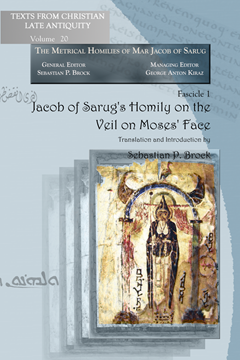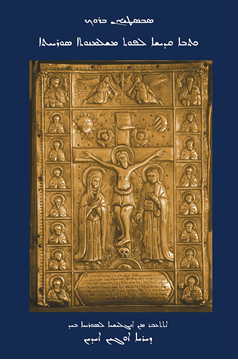Sebastian P. Brock

Emeritus Reader in Syriac Studies, Oxford University, and Emeritus Fellow of Wolfson College, Oxford. Author of a number of contributions in the area of Syriac studies (including several books published by Gorgias Press).
Selected Dialogue Poems [Sugyotho Mgabyotho]
Series: Bar Ebroyo Kloster Publications 1
ISBN: 978-1-59333-442-0
Dialogue poetry is a genre that began in ancient Sumer and continues in rich fashion in the Syriac tradition. Sebastian Brock has selected an edition of twenty six dialogue poems: between the Church and Zion; Abraham and Isaac; Joseph and Benjamin; the body and the soul; Joseph and Mary; the thief and the cherub; Mary and the Magi; the church and the believers; the angel and Mary; among the months of the year; between the angel and Zachariah; death and Satan; Jesus and the faithful; the two thieves; Jesus and John; the sinful woman and Satan; Abel and Cain; and wheat and gold.
$119.00 (USD)
Jacob of Sarug’s Homily on the Veil on Moses’ Face
Metrical Homilies of Mar Jacob of Sarug
Translation and Introduction by Sebastian P. Brock
Series: Texts from Christian Late Antiquity 20
ISBN: 978-1-59333-644-8
This edition of Mar Jacob of Sarug's (d. 521) homily on the Veil of Moses asks what the veil means. Jacob finds the hermeneutical key in Paul’s exegesis of Gen. 2:24 – that the man and the woman becoming one symbolizes Christ and the Church. The bride must wear a veil until such time as her bridegroom comes to remove it at their marriage ceremony. The volume constitutes a fascicle of The Metrical Homilies of Mar Jacob of Sarug, which, when complete, will contain the original Syriac text of Jacob's surviving sermons, fully vocalized, alongside an annotated English translation.
$34.00 (USD)
The Christian Heritage of Iraq
Collected papers from the Christianity of Iraq I-V Seminar Days
Edited by Erica C. D. Hunter
Series: Gorgias Eastern Christian Studies 13
ISBN: 978-1-60724-111-9
Iraq has been a centre of Syriac Christianity for almost two thousand years. This volume of collected papers from the Christianity in Iraq I-V Seminar Days (2004-2008) explores the Christian heritage of Iraq, highlighting the churches’ innate ability to transcend barriers of language, culture, ethnicity and religion.
$193.00 (USD)
The History of the Holy Mar Ma‘in
With a Guide to the Persian Martyr Acts
ISBN: 978-1-59333-222-8
The History of Holy Mar Ma‘in of Sinjar tells the story of a Sasanian general during the time of Shapur II (309-79) who suffered persecution after his conversion to Christianity. In this volume, the first in this new series from Gorgias Press, Sebastian P. Brock provides the first edition ever of the Syriac text of the History of Ma‘in as well as the first full translation of it. This volume also includes a basic guide to the whole corpus of Persian Martyr Acts as well as useful indices to these numerous texts.
$44.00 (USD)
The Edessa-Aleppo Syriac Codex of the Chronicle of Michael the Great
Edited by Gregorios Yohanna Ibrahim; Contribution by Sebastian P. Brock & Hidemi Takahashi; Foreword by George Anton Kiraz
ISBN: 978-1-59333-147-4
The invaluable Chronicle of Michael the Great makes the scholarly resources on this unique manuscript available together for the first time. Now inaccessible, the Chronicle is the largest medieval chronicle known, and is available here for the first time in history as a facsimile copy of the original manuscript. The Chronicle is one of the most important primary sources on the history of the Middle East, especially the period between the rise of Islam and the Crusades.
$292.00 (USD)
The Wisdom of Isaac of Nineveh
A Bilingual Edition
Series: Texts from Christian Late Antiquity 1
ISBN: 1-59333-335-8
From one of the most thought-provoking writers in the monastic tradition, this volume contains 153 short, contemplative sayings of St. Isaac of Nineveh (fl. 661-681 CE) in their original Syriac with facing English translation. St. Isaac was ordained bishop of Nineveh but resigned his post only five months later and became a monastic hermit in the mountains of southeastern Iraq. This work speaks to believing Christians today as well as scholars wishing to learn more about the Eastern monastic tradition.
$32.00 (USD)
The Bible in the Syriac Tradition (Syriac Version)
Translated from English into Syriac by Eugene Aydin
ISBN: 1-931956-15-4
This is an introduction, written in Syriac, to the Syriac versions of the Bible, with chapters on the manuscript tradition, the main editions, commentaries, and various aspects of the ways the Bible was interpreted and used in the Syriac literary and liturgical tradition. Originally written for a Syriac Studies course at the St Ephrem Ecumenical Research Institute (SEERI), in Kottayam, India, this new edition has been brought up to date and the bibliography expanded.
$70.00 (USD)
The Hidden Pearl (vol. 3)
Vol. 3: At the Turn of the Third Millennium; The Syrian Orthodox Witness
ISBN: 1-931956-99-5-3
Despite tremendous challenges, Syriac culture and language has survived to the present day. However, massacres and forced migrations have forced Syriac communities to seek homes outside the Middle East, including Germany, the Netherlands, Sweden, America, and Australia. This volume looks at the changing face of Syriac culture in the new millennium and in particular the measures that are being taken to successfully adapt to its new environments. Includes color photographs.
$50.00 (USD)
The Hidden Pearl (vol. 2)
Vol. 2:
ISBN: 1-931956-99-5-2
Aramaic, the language of Jesus of Nazareth, was the lingua franca of the Middle East for over a thousand years before Arabic became widespread. This volume focuses on the Late Antiquity period and how Syriac Christianity emerges from Jewish Aramaic and the course of these two Aramaic traditions. The second part of this volume focuses on the Syriac tradition and its cultural role, the importance of Syriac scholars, and the spread of Syriac Christianity eastward in the first millennium AD. Includes both color and black and white illustrations.
$50.00 (USD)

![Show details for Selected Dialogue Poems [Sugyotho Mgabyotho] ImageFromGFF](https://gorgiaspress.com/images/thumbs/0005821_selected-dialogue-poems-sugyotho-mgabyotho_360.png)






